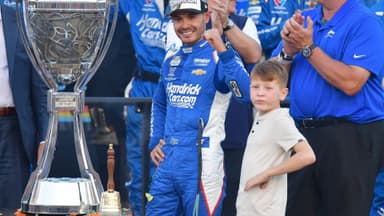Motorsports enthusiasts often believe that drivers who master the racetracks navigating through the competitive crowd would exhibit similar abilities on public roads as well. However, Kyle Larson serves as a prime example that such assumptions don’t always hold water. While he’s certainly capable behind the wheel, his approach to public driving contrasts sharply with his racetrack tactics.
Advertisement
In a 2019 interview with Jeff Gluck, where Larson faced a rapid-fire of 12 questions, one topic that came up was the difference between road rage and aggressive maneuvers on the racetrack.
Larson highlighted the distinct difference, explaining, “If somebody cuts you off or something like that, then at least in the race car, you can run into them and show your displeasure.”
“Where I guess on the street, if somebody cuts me off, I just tailgate them for a couple miles. Yeah, or at least until they turn. So I would say it’s similar, just you can’t run into somebody on the street,” the Hendrick Motorsports ace quoted further.
Besides, he doesn’t even do hand gestures on the public roads unlike racetracks because, “If you do a hand gesture and somebody gets you to pull over on the side of the road, they’d probably beat you up and you don’t have any backup.”
Larson is typically calm and composed during post-race interviews, even when he’s been muscled out of contention by another driver on and off the racetrack.
How does Larson fare as a passenger?
This season, Larson led the pack with six victories, even after sitting out one race due to weather delays during the Coca Cola 600 and Indy 500 double header. Yet, for all his abilities on the track, Larson admitted to struggling when he’s not in the driver’s seat—especially when his wife, Katelyn, is at the helm.
“I’m not the passenger too often, but with Katelyn, when I’m the passenger, I’m really bad. When I’m with J.P. [manager Josh Peterman], I’m not too bad,” Larson shared during a segment on The Athletic’s 12 Questions podcast in 2023.
When riding with his wife, Larson doesn’t consider himself as just a passenger; he’s an involuntary co-pilot, grappling with the slower pace and navigating through traffic, which he finds particularly challenging. “With Katelyn, it’s like, ‘You’re clear, get over’ or ‘Pass these cars. I’m definitely driving from the passenger seat, but she rarely drives,” he explained.




